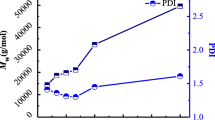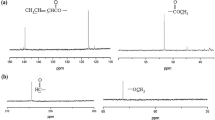Abstract
Poly(caprolactone) (PCL) was synthesized from the polymerization of ε-caprolactone (CL) with degraded poly(ethylene terephthalate) (PET) for its functionalization using heptamolybdate of ammonium and tin(II) 2-ethylhexanoate, as catalyst and initiator, respectively. Polymerization of CL with bis(2-hydroxyethyl) terephthalate (BHET) was carried out to make a comparison. From the analysis by FTIR, the functional groups of polycaprolactone and degraded PET were identified by FTIR. The chemical shift at 165.59 ppm obtained by NMR corresponded to the chemical bond between the carbonyl of the PCL bound to the -CH2CO2-C10H8O4 of the degraded PET. The number average molar mass of polymer obtained was determined and its chemical structure was proposed. Crystallinity and the temperatures of melting and degradation depended of the mass of degraded PET used in the synthesis. Based on the proposed chemical structure, the synthesized polymer could be used in the preparation of other polymers.









Similar content being viewed by others
References
Maris J, Bourdon S, Brossard J, Cauret L, Fontaine L, Montembault V (2018) Mechanical recycling: Compatibilization of mixed thermoplastic wastes. Polym Degrad Stab 147:245–266
Singh N, Hui D, Singh R, Ahuja IPS, Feo L, Fraternali F (2017) Recycling of plastic solid waste: a state of art review and future applications. Composites Part B 115:409–422
Rahimi A, García JM (2017) Chemical recycling of waste plastics for new materials production. Nat Rev Chem:1–11
Wojciech BJ (2015) Thermal utilization (treatment) of plastic waste. Energy, vol 90, pp 1468–1477
Al-Sabagh AM, Yehia FZ, Eshaq G, Rabie AM, ElMetwally AE (2016) Greener routes for recycling of polyethylene terephthalate. Egypt J Pet 25:53–64
Zhou X, Wang C, Fang C, Yu R, Li Y, Lei W (2019) Structure and thermal properties of various alcoholysis products from waste poly(ethylene terephthalate). Waste Manag 85:164–174
Tamio E, Lakshmi R, Hiroaki N, Satoru K, Yoshinobu N, Kazuhiro E (2017) Composite engineering–direct bonding of plastic PET films by plasma irradiation. Procedia Eng 171:88–103
Ren M, Zhang Z, Wu S, Wei J, Xiao C (2006) Uniaxial orientation and crystallization behavior of amorphous poly(ethylene terephthalate) fibers. J Polym Res 13:9–15
Awaja F, Pavel D (2005) Recycling of PET. Eur Polym J 41:1453–1477
Abdelaal MY, Sobahi TR, Makki MS (2008) Chemical degradation of poly(ethylene terephthalate). Int J Polym Mater 57:73–80
Sharma V, Shrivastava P, Agarwal D (2015) Degradation of PET-bottles to monohydroxyethyl terephthalate(MHT) using ethylene glycol and hydrotalcite. J Polym Res 22:241
Mohammadi SR, Khonakdar HA, Ehsani M, Jafari SH, Wagenknecht U, Kretzschmar B (2011) Investigation of thermal behavior and decomposition kinetic of PET/PEN blends and their clay containing nanocomposites. J Polym Res 18:1765–1775
Paszun D, Spychaj T (1997) Chemical recycling of poly(ethylene terephthalate). Ind Eng Chem Res 36:1373–1383
Hsiao KJ, Jen ZF, Yang JC, Chen LT (2002) Physical properties of R-PET/CD-PET polyblended hollow filaments and their kinetics of alkaline hydrolysis. J Polym Res 9:53–59
Yoshioka T, Motoki T, Okuwaki A (2001) Kinetics of Hydrolsis of PET powder in nitric acid by a modified shrinking Core model. Ind Eng Chem Res 40:75–79
Espinoza GK, Navarro R, Ramírez-Hernández A, Marcos-Fernández A (2017) New routes to difunctional macroglycols using ethylene carbonate: reaction with bis-(2-hydroxyethyl) terephthalate and degradation of poly(ethylene terephthalate). Polym Degrad Stab 144:195–206
Makino Y, Hirata T (1997) Modified atmosphere packaging of fresh produce with a biodegradable laminate of chitosan-cellulose and polycaprolactone. Postharvest Biol Technol 10:247–254
Stanley N, Bucataru G, Miao Y, Favrelle A, Bria M, Stoffelbach F, Woisel P, Zinck P (2014) Brönsted acids catalyzed polymerization of ε-caprolactone in water, a mild and straightforward route to poly(ε-caprolactone)-graft-water-soluble polysaccharides. J Polym Sci Chem 52:2139–2145
Jikei M, Takeyama Y, Yamadoi Y, Shinbo N, Matsumoto K, Motokawa M, Ishibashi K, Yamamoto F (2015) Synthesis and properties of poly(L-lactide)-poly(ε-caprolactone) multiblock copolymers by the self-polycondensation of diblockmacromonomers. Polym J 47:657–665
Sisson AL, Duygu E, Andreas L (2013) The contemporary role of ε-caprolactone chemistry to create advanced polymer architectures. Polym 54:4333–4350
Ting-Yu S, Yang J, Jui-Hsiang C (2012) Synthesis, characterization and evaluation of segmented polycaprolactone for development of dura substitute. Procedia Eng 36:144–149
Báez JE, Martínez-Rosales M, Martínez-Richa A (2003) Ring-opening polymerization of lactones catalyzed by decamolybdate anion. Polym 44:6767–6772
Penczek S, Duda A, Kowalski A, Libiszowski J, Majerska K, Biela T (2000) On the mechanism of polymerization of cyclic esters induced by tin(II) octoate. Macromol Symp 157:61–70
Storey RF, Taylor AE (1998) Effect of stannous octoate on the composition, molecular weight, and molecular weight distribution of ethylene glycol-initiated poly(ε-caprolactone). J Macromol Sci Part A 35:723–750
Kiersnowski A, Budde H, Kressler J, Piglowski J (2004) Synthesis and structure of poly(ε-caprolactone)/synthetic montmorillonite nano-intercalates. Eur Polym J 40:2591–2598
Asuman C, Nurufe K, Ramazan O, Ali EM, Faruk Y (2009) Synthesis, characterization and thermal properties of a novel star polymer consisting of poly(ε-caprolactone) arms emanating from an octa-functional porphyrazine core. React Funct Polym 69:705–713
Báez JE, Ramírez-Hernández A, Marcos-Fernández Á (2010) Synthesis, characterization, and degradation of poly(ethylene-b-ε-caprolactone) diblock copolymer. Polym Adv Technol 21:55–64
Ramírez-Hernández A, Martínez-Richa A (2010) Ring opening polymerization of ε-Caprolactone initiated by Decamolybdate anion: determination of kinetic and thermodynamic parameters by DSC and 1H-NMR. J Appl Polym Sci 115:2288–2295
He Y, Inoue Y (2000) Novel FTIR method for determining the crystallinity of poly(ε-caprolactone). Polym Int 49:623–626
Gómez-Lizárraga K, Flores-Morales C, Del Prado-Audelo ML, Álvarez-Pérez MA, Piña-Barba MC, Escobedo C (2017) Polycaprolactone-and polycaprolactone/ceramic-based 3D-bioplotted porous scaffolds for bone regeneration: a comparative study. Mater Sci Eng C 79:326–335
Corden TJ, Jones IA, Rudd CD, Christian P, Downes S, McDougall KE (2000) Physical and biocompatibility properties of poly-ε-caprolactone produced using in situ polymerisation: a novel manufacturing technique for long-fibre composite materials. Biomater 21:713–724
Elzein T, Nasser-Eddine M, Delaite C, Bistac S, Dumas P (2004) FTIR study of polycaprolactone chain organization at interfaces. J Colloid Interface Sci 273:381–387
Spěváček J, Brus J, Divers T, Grohens Y (2007) Solid-state NMR study of biodegradable starch/polycaprolactone blends. Eur Polym J 43:1866–1875
Yanrong G, Tao D, Pengtao F, Qing Z, Xingmei L, Suojiang Z (2015) Fast and effective glycolysis of poly(ethylene terephthalate) catalyzed by polyoxometalate. Polym Degrad Stab 117:30–36
Kong Y, Hay JN (2003) The enthalpy of fusion and degree of crystallinity of polymers as measured by DSC. Eur Polym J 39:1721–1727
Wang Y, Rodriguez-Perez MA, Reis RL, Mano JF Thermal and thermomechanical behaviour of Polycaprolactone and starch/Polycaprolactone blends for biomedical applications. Macromol Mater Eng 38, 290:792–801
Ramírez-Hernández A, Mata-Mata JL, Aparicio-Saguilán A, González-García G, Hernández-Mendoza H, Gutiérrez-Fuentes A, Báez-García E (2016) The effect of ethylene glycol on starch-g-PCL graft copolymer synthesis. Starch/starke 68:1148–1157
Ramírez-Hernández A, Aparicio-Saguilán A, Mata-Mata JL, González-García G, Hernández-Mendoza H, Gutiérrez-Fuentes A, Báez-García E (2017) Chemical modification of banana starch by the in situ polymerization of ϵ-caprolactone in one step. Starch / Stärke 69:1600197
Acknowledgements
We are grateful to Universidad del Papaloapan and Martha Rocio Valencia Estacio, for their assistance on this article.
Author information
Authors and Affiliations
Corresponding author
Additional information
Publisher’s note
Springer Nature remains neutral with regard to jurisdictional claims in published maps and institutional affiliations.
Electronic supplementary material
ESM 1
(DOCX 510 kb)
Rights and permissions
About this article
Cite this article
Espinoza-García, K., Marcos-Fernández, A., Navarro, R. et al. Polymerization of ε-caprolactone with degraded PET for its functionalization. J Polym Res 26, 180 (2019). https://doi.org/10.1007/s10965-019-1821-6
Received:
Accepted:
Published:
DOI: https://doi.org/10.1007/s10965-019-1821-6




